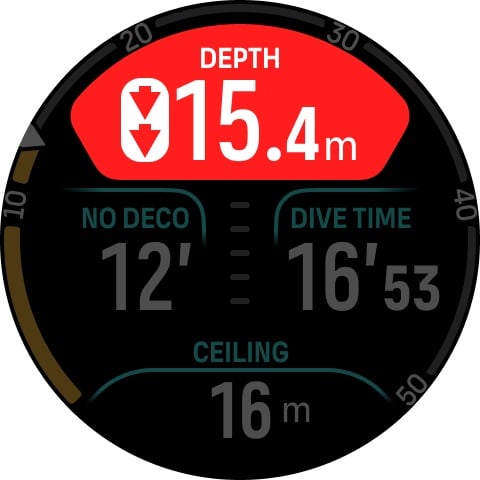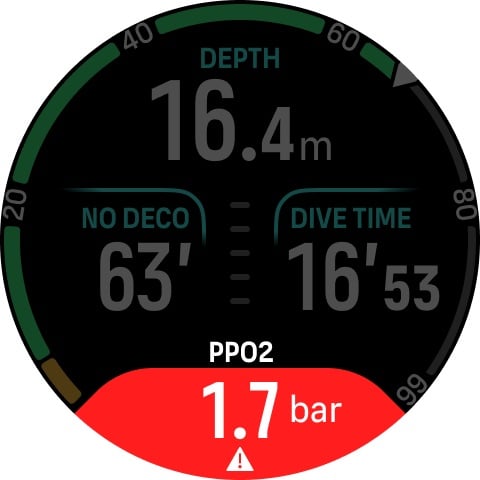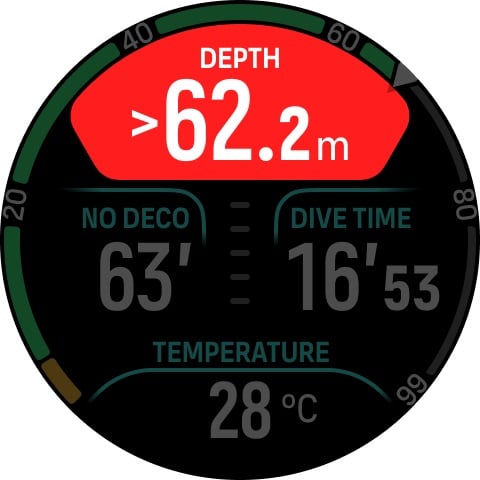Suunto Ocean User Guide
Dive alarms
Suunto Ocean has color-coded mandatory warnings. They are shown prominently on the display with an audible and vibration alarm. Warnings are always red and they are critical events that always require immediate action. You can dismiss the audio and vibration but the warning will stay red until the situation has been resolved.
With Suunto Ocean, you can also define your own alarms and set the preferred audio, vibration and appearance.
Mandatory dive alarms
The following table shows all the mandatory warnings you may see during a dive. You can find the reason for the alarm and the solution of the issue in the table.
If multiple alarms occur simultaneously, the error with the highest priority will be displayed. Acknowledge the first alarm by pressing any button and the next one will appear.
| Alarm | Explanation | How to resolve the alarm? |
|---|---|---|
 | Ascent speed exceeds safe speed of 10 m (33 ft) per minute for five seconds or more. | Stay within the green ascent rate indicators. Monitor for symptoms of DCS. Use extra conservatism for future dives. |
 | Decompression ceiling broken by more than 0.6 m (2 ft) on a decompression dive. | Descend deeper than the displayed ceiling value. |
 | Partial pressure of oxygen exceeds the maximum level (>1.6). | Immediately ascend or change to a gas with lower oxygen percentage. |
 | Partial pressure of oxygen exceeds the set level for the gas. | Immediately ascend or change to a gas with lower oxygen percentage. |
 | Central Nervous System (CNS) Oxygen Toxicity level at 80% or 100% limit. | Switch to a gas with a lower ppO2 or ascend shallower (within decompression ceiling). |
 | 80% or 100% of recommended daily limit for OTU reached. | Switch to a gas with a lower ppO2 or ascend shallower (within decompression ceiling). |
 | Tank pressure is below 50 bar (725 psi). | Change gas to a higher tank pressure or ascend to safety stop depth and terminate dive. |
 | Depth exceeds the maximum depth (60 m) your watch should be used at. If diving beyond 60 m, the dive computer will not show accurate depth value or algorithm info. | Ascend to a shallower depth and follow computer for ascend profile. Monitor for symptoms of DCS. Use extra conservatism for future dives. |
 | Not inside the safety stop window. | Stay within the safety stop window 3 m – 6 m. |
 | NDL is less than 5 minutes. | Ascend shallower to avoid mandatory decompression stops. |
 | The decompression ceiling is broken for more than 3 min and your decompression stop is missed. | Descend to the ceiling depth indicated in the switch window. |
 | Your NDL reaches 0 min, and decompression stops are mandatory. | Perform decompression stops as directed and always stay deeper than the ceiling value. |
 | Battery is low (<10%) or critical (<5%). | Recharge the device. |
User configurable dive alarms
In addition to the mandatory alarms, there are additional user configurable tank pressure, depth, dive time and NDL alarms. For each alarm, you can customize the audio tone to short or long or you can have all tones off. In addition to the audio option, you can also choose to have a vibration alert or if you prefer to have all tones silent, you can have only vibration on.
In addition to the audible and vibration options, you can choose between two different appearance options: Notify (cyan) or Caution (yellow). You can define a maximum of five alarms for each configurable alarm and once an alarm appears, you can clear it by pressing any button.



Tank pressure
You can set the tank pressure alarm to any value between 51–360 bar (725–5221 psi). A mandatory 50 bar (725 psi) alarm is present and it cannot be modified. Tank pressure alarms are useful to notify you when reaching your turn pressure.


Depth
You can define a depth alarm between 3.0 m and 59.0 m. Depth alarms are convenient to have especially when freediving to notify you of different phases of the freedive. You can also set a depth alarm to notify you when reaching your personal depth limit during diving.


Dive time
Dive time alarms can be defined in minutes and seconds to a maximum of 99 min.

NDL
No decompression limit (NDL) alarms can be defined to alert you of a certain NDL or when you are low on NDL time.

System errors
All computers experience failures. It is possible that this device may suddenly fail to provide accurate information during your dive. Always have a plan on how to handle failures, use a backup dive device and only dive with a buddy. In the unlikely event that the dive computer malfunctions during a dive, follow the emergency procedures provided by your certified dive training agency to immediately and safely ascend. Contact Suunto customer support if you experience a system error.